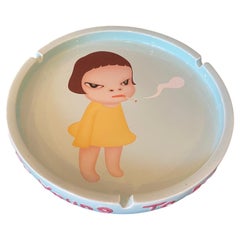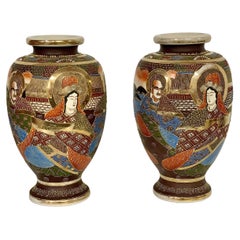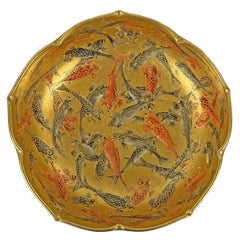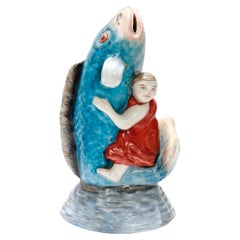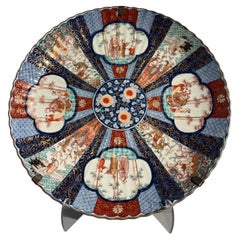Japanese Ceramics
to
356
496
388
919
523
32
33
10
4
4
4
4
3
1
59
457
403
555
160
92
40
33
4
7
11
4
7
3
6
5
3
1,407
927
389
237
89
4,170
3,542
1,953
1,474
511
1,474
1,459
1,459
28
17
16
12
9
Place of Origin: Japanese
Yoshitomo Nara, Too Young to Die, Japanese Glazed Porcelain Ceramic Ashtray 2002
By Yoshitomo Nara 1
Located in Studio City, CA
A beautiful and highly coveted large finely glazed ceramic ash tray/ low bowl by famed Japanese Pop artist Yoshitomo Nara (奈良 美智, 1959- ) titled "Too Young To Die". The wonderful im...
Category
Early 2000s Modern Japanese Ceramics
Materials
Ceramic, Porcelain
Pair of Japanese Satsuma 'Moriage' Porcelain Gilt Vases
By Satsuma
Located in LA CIOTAT, FR
This handsome pair of 20th century glazed and gilded Japanese Satsuma vases, with their vivid, jewel-like colours and elegant baluster-shaped forms, feature the traditional Japanese ...
Category
20th Century Japanese Ceramics
Materials
Porcelain
Japanese Meiji Period Satsuma Vase by Ryokuzan
Located in Newark, England
From our Japanese Satsuma Collection, we are delighted to offer this Japanese Satsuma Vase by Ryokuzan 緑山. The Satsuma vase of ovoid shape with a tapered body, circular foot rim, wai...
Category
Early 1900s Meiji Antique Japanese Ceramics
Materials
Ceramic, Earthenware, Pottery
19th Century Japanese Satsuma Koi Bowl
Located in Chicago, IL
This extraordinary 19th-century Meiji period Japanese Satsuma lotus-form bowl is an epitome of artistic mastery and cultural significance. Adorned meticulously with red and black koi...
Category
19th Century Meiji Antique Japanese Ceramics
Materials
Porcelain
Antique Japanese Okimono Porcelain Figurine of Kintaro
Located in Philadelphia, PA
A fine vintage Japanese porcelain figurine or okimono.
Depicting Kintaro (金太郎) wrestling a giant catfish or koi fish.
Kintaro (...
Category
Mid-20th Century Japanese Ceramics
Materials
Porcelain
Large Japanese Imari Fluted Charger, Edo/Meiji Period, Mid 19th Century, Japan
Located in Austin, TX
A large and impressive Japanese Imari porcelain fluted charger with scalloped rim, signed Kaji(chu?), Edo to Meiji Period, mid 19th century, Japan.
The magnificent Japanese Imari charger measures 25" in diameter, and is decorated in the typical imari palette of underglaze blue with overglaze red, orange, blue, and green enamels with gilt highlights. The large charger also features fluted sides and a scalloped gilt rim.
The design of the charger is centered on a central floral medallion with three large chrysanthemum blossoms and vegetal scrolls. Radiating out from the central medallion are various brocade patterned sections that roughly follow the shape of the fluting. Some larger sections feature images of cranes and minogame (turtles with long tails), both symbols of longevity, while other feature dragons and phoenix, symbols of authority and power. Four large reserves depict charming scenes of a scholar and his students within a bamboo grove having discourse and examining scrolls.
The back of the charger decorated in underglaze blue with bold floral and vegetal scrolls. With a three character inscription in underglaze blue reading Kaji(chu?) Sei.
The charger is fitted with an antique metal hanger...
Category
Mid-19th Century Meiji Antique Japanese Ceramics
Materials
Porcelain
Meiji Period High Relief Porcelain Celadon Vase, circa 1900
Located in Miami, FL
This captivating Meiji period (1868-1912) porcelain vase features a mesmerizing celadon glaze, with a subtle crackled texture. Exquisite details, meticulously hand-painted in vibrant...
Category
Early 20th Century Meiji Japanese Ceramics
Materials
Porcelain
Large 19th Century Japanese Imari Ware Porcelain Vase
Located in Bradenton, FL
A large scale and very good quality late 19th century Japanese Imari vase with exotic birds, trees and flowers. Wonderful coloring in vibrant hues of blue, red and rust.
Category
19th Century Japonisme Antique Japanese Ceramics
Materials
Porcelain
Japanese Antique Muromachi Edo Wabi-Sabi Tokoname Art Pottery Jar Tsubo Pot Vase
Located in Studio City, CA
An absolutely stunning Tokoname ware stoneware vase/jar/vessel - produced sometime during the late Muromachi period (1336-1573 to early Edo Period (1603-1867). Tokoname-yaki ware is ...
Category
16th Century Edo Antique Japanese Ceramics
Materials
Pottery, Stoneware
Japanese Arita Blue and White Kraak Dish - Edo Period, late 17th
By 1616 / Arita Japan
Located in DELFT, NL
A 17th Century Japanese Blue and White Porcelain Dish in the Kraak Style, Arita Kilns 1670 – 1700.
The central design shows three pheasant, one perched on a rock amongst flowering p...
Category
Late 17th Century Edo Antique Japanese Ceramics
Materials
Porcelain
Shoji Hamada Mingei Kakiyu Kaki Glaze Japanese Studio Pottery Yunomi Teacup
By Shoji Hamada
Located in Studio City, CA
An exquisite, beautifully crafted, and wonderfully designed Yunomi teacup by master Japanese potter Shoji Hamada featuring his wax-resistant technique and highly coveted rich Kaki glaze over Mashiko...
Category
Mid-20th Century Showa Japanese Ceramics
Materials
Stoneware
Pair Large Antique Japanese Meiji Period Porcelain Imari Lidded Jars Urns, 1880
Located in Portland, OR
A good pair of large antique Japanese Meiji period porcelain lidded jars, circa 1880.
The jars having ribbed dome shaped lids topped with lion-dog (Komainu) finials, the baluster shaped jars also of corresponding ribbed form. The lids and jars are skillfully hand-decorated in the Imari palette with blue & iron red floral decoration over a white body, on one side are a pair of floral cartouches on another side is a fan shaped cartouche.
Condition is very good indeed, no damage or restoration, a very handsome pair of 19th century Japanese Imari lidded jars...
Category
1880s Meiji Antique Japanese Ceramics
Materials
Porcelain
Pair of Japanese Moriage Satsuma Vases with Gold Gilding Circa 1930-1940
Located in Ixelles, BE
Japanese Satsuma vases from the circa 1930-1940 period are a particular style of ceramic art that originated from the Satsuma province of Japan. Satsuma ware is renowned for its intricate hand-painted designs, rich colors, and distinctive crackled glaze.
Satsuma ware dates back to the early 17th century, but it gained widespread popularity in the late 19th and early 20th centuries, including the 1930s and 1940s. Satsuma vases produced during this time often reflected a mix of traditional and modern influences, as Japan went through a period of cultural exchange and artistic experimentation.
Satsuma vases are made from a type of Japanese earthenware clay known for its fine texture and malleability. The vases are hand-formed or wheel-thrown and then meticulously hand-painted with intricate designs using enamel paints. The distinctive crackled glaze was achieved by firing the vases at a relatively low temperature, allowing the glaze to crack during the cooling process.
The moriage technique involves applying three-dimensional, raised ornamentation to the surface of the ceramic piece, creating a visually textured and layered effect. Artisans create three-dimensional patterns, designs, or intricate motifs using a special mixture of clay, slip, or porcelain paste. The raised elements are added by hand to the ceramic body, and each detail is carefully shaped to achieve the desired effect.
The moriage is then gold gilded as some of the intricate ornamental patterns and the halos around the three immortal...
Category
Early 20th Century Showa Japanese Ceramics
Materials
Pottery
Antique Meiji Japanese Satsuma Porcelain Hand Painted Millefleur Bowl by Hakusan
Located in Portland, OR
An outstanding, fine, antique Japanese Meiji Period (1868-1912) Satsuma Millefleur pottery bowl, by Hakusan, circa 1890.
This outstanding Satsuma bowl is very finely handpainted & gi...
Category
1890s Meiji Antique Japanese Ceramics
Materials
Porcelain
Antique Japanese Meiji Period Satsuma Vase by Okamoto Ryozan for Yasuda Company
Located in Newark, England
MUSEUM QUALITY SATSUMA VASE BY OKAMOTO RYOZAN
From our Japanese Satsuma collection, we are absolutely delighted to bring to market this exceptional Japanese Satsuma Vase by Okamoto...
Category
Early 1900s Meiji Antique Japanese Ceramics
Materials
Ceramic
Japanese Hand Painted Ceramic Cat Sculpture
Located in Douglas Manor, NY
3-726 vintage Japanese hand painted ceramic cat sculpture
Category
1950s Vintage Japanese Ceramics
Materials
Ceramic
Wonderful quality antique Japanese imari plate
Located in Ipswich, GB
Wonderful quality antique Japanese imari plate with a wavy shaped edge, decorated highly with flowers and leaves hand painted in stunning red, white, blue and gold colours.
D. 1900
Category
20th Century Japanese Ceramics
Materials
Ceramic
Meiji Satsuma Earthenware Urn or Vase with Foo Dog Sculpture, circa 1880
By Satsuma
Located in Atlanta, GA
A magnificent testament to the artistry of the Japanese Meiji period (1868-1912), this rare Satsuma earthenware urn is an extraordinary find. Crafted in Japan circa 1880, its delicat...
Category
Late 19th Century Meiji Antique Japanese Ceramics
Materials
Earthenware
Japanese Meiji Period, Blue and White Vase with Phoenix Decoration
Located in New York, NY
A Palace Size Japanese Meiji Period (1868-1912) Blue and White Vase with Phoenix Decoration. This vase is absolutely beautiful with an incredible array of hand-painted blue decoratio...
Category
1890s Meiji Antique Japanese Ceramics
Materials
Porcelain
Japanese Satsuma Vase
Located in Douglas Manor, NY
Japanese Satsuma hand decorated vase.
Category
1920s Vintage Japanese Ceramics
Materials
Ceramic
#11 Antique Meiji Period Japanese Satsuma Autumn Tea Set 19th Century Wisteria
Located in Amsterdam, Noord Holland
Fabulous Tea set Satsuma of 11 pieces. Meiji period, 19th century
Marked:
Condition
1 cup with small frits/fleebites rim, rest perfect. Size jugs 110-140mm high cups 90x45mm DXH and...
Category
19th Century Qing Antique Japanese Ceramics
Materials
Porcelain
Meiji Japanese Porcelain Imari Charger
Located in Los Angeles, CA
18 Inch Japanese Imari Charger - very large and decorative. The mixed illustrative painted scenes are with great pattern and texture, and mixed with floral and organic images of blos...
Category
19th Century Meiji Antique Japanese Ceramics
Materials
Porcelain
Mid-20th Century Japanese Kutani Blue Moriage Dragonware Teapots set
Located in Pomona, CA
Beautiful vintage Japanese blue Moriage teapots set. Hand painted richly decorated with a dense gilt & Dragon pattern Comprising. Nice vintage shape with only a small hair line on th...
Category
Mid-20th Century Anglo-Japanese Japanese Ceramics
Materials
Ceramic
Large Meiji Period Cloisonne Enamel Vase
Located in London, GB
Of ovoid form, with a narrow neck and outward flaring rim, on dark blue ground depicting wisteria blossoms in white and purple cascading from the shoulder with birds throughout and w...
Category
Late 19th Century Meiji Antique Japanese Ceramics
Materials
Enamel
Antique 19th Century Japanese Porcelain Yoshidaya Kutani Large Dish, Japan
Located in Amsterdam, Noord Holland
Sharing with you this lovely and unusal Kutani porcelain large dish. The dish is of circular form and has a scene of a wise man and his apprentice in a landscape scene. With beautiful colors and very nicely painted.
Base marked with a Fuku mark...
Category
19th Century Qing Antique Japanese Ceramics
Materials
Porcelain
Japanese Meiji Period (1868-1912) Satsuma Earthenware Vase Taizan for Hattori
Located in Newark, England
Meiji Period (1868-1912)
From our Japanese collection, we are delighted to offer Japanese Meiji Period Satsuma Vases. The Satsuma Vase of hexagonal form with a slight waisted neck and tight rounded rim is extensively decorated with multiple figures to two large scenes. The first scene features a beach with waves to the background and a plethora of figures including multiple geisha holding traditional Japanese wagasa’s. The second scene follows on from the first with a large building in the foreground holding figures on a large platform under a pagoda roof with a pagoda building in the background and further figures in the foreground. The scenes are framed by a full detailed border with gilt shapes, flowers amongst pink shaded backgrounds and butterflies around the neck. The Satsuma Vase is unusually signed Fine Art, Satsuma Ware, Dai Nippon (Great Japan), Hattori Made, Gosuido Works, Taizan Painted. 美術, サツマヤキ(薩摩焼), 大日本, 服部造, 五スイ堂工, 對山画 and dates to the Meiji Period (1868-1912) and the turn of the 20th century circa 1905.
Satsuma ware is a type of earthenware pottery originating from the Satsuma province in Southern Kyushu, Japan’s third largest island.
Wagasa are traditional Japanese umbrellas made of washi paper attached to a bamboo frame and treated to ensure it is waterproof.
Meiji Period was an era of Japanese history that spanned from 1868 to 1912. It was the first half of the Empire of Japan, when the Japanese people began to build a paradigm of a modern, industrialised nation state and emergent great power, influenced by Western countries and aesthetics. As a result of radically different ideas, the changes to Japan were profound and it affected the social structure, politics, economy, military, and foreign relations across the board. The period corresponded to the reign of Emperor Meiji and was preceded by the Keio era and was succeeded by the Taisho era.
Cultural Art during the Meiji Period was of particular interest to the government and they overhauled the art export market which in turn promoted Japanese arts via various world’s fairs, beginning in Vienna at the world fair in 1873. The government heavily funded the fairs and took an active role organising how Japan’s culture was presented to the world including creating a semi-public company named Kiritsu Kosho Kaisha (First Industrial Manufacturing Company). The Kiritsu Kosho Kaisha was used to promote and commercialise exports of Japanese art and established the Hakurankai Jimukyoku (Exhibition Bureau) to maintain quality standards. For the 1876 Centennial International Exhibition in Philadelphia, the Japanese government created a Centennial Office and sent a special envoy to secure space for the 30,000 items that would be displayed. The Imperial Household also took an active interest in arts and crafts, commissioning works by select artists to be given as gifts for foreign dignitaries further emphasising the high quality and importance of Japanese art. Just before the end of the 19th century in 1890, the Teishitsu Gigeiin (Artist to the Imperial Household) system was created to recognise distinguished artists. These artists were selected for their exceptionally high quality wares and talent in their own industry. Over a period of 54 years Seventy artists were appointed, amongst these were ceramicist Makuzu Kozan and cloisonné enamel artist...
Category
Early 1900s Meiji Antique Japanese Ceramics
Materials
Earthenware, Pottery
Kaneshige Toyo National Treasure Signed Japanese Bizen Pottery Sake Bottle Vase
Located in Studio City, CA
A beautiful, perfectly shaped and balanced antique Bizen ware shibui sake bottle (tokkuri) vase by renowned Japanese master potter/artist Kaneshige Toyo (1896-1967) featuring a unique natural, wonderfully textured organic forming ash glaze. Kaneshige is universally considered to be the founder of modern Bizen pottery.
In 1956, Kaneshige was certified as a Living National Treasure (Important Intangible Cultural Heritage) for his work in Bizen Ware pottery/ceramics. Bizen Ware is a type of Japanese pottery traditionally from the Bizen province, presently a part of the Okayama prefecture. It is considered one of the Six Ancient Japanese Kilns (along with Echizen ware, Seto ware, Shigaraki ware, Tamba ware, and Tokoname ware).
The piece is signed/ sealed on the base with one of Kaneshige's traditional incised marks.
A rather striking and engaging work. One of the best Kaneshige works we have come across. Scarce and hard to find in such an excellent condition. Would be a fantastic addition to any Japanese/Asian pottery or Bizen Ware collection or eye-catching stand-alone work in about any setting.
Kaneshige's work can be found in numerous prominent collections and museums including:
Aichi Prefectural Ceramic Museum, Seto, Japan
Brooklyn Museum, NY
Hagi Uragami Museum, Yamaguchi, Japan
Honolulu Art Museum, HI
Ibaraki Ceramic Art Museum, Kasama, Japan
Indiana Art...
Category
Mid-20th Century Showa Japanese Ceramics
Materials
Stoneware
Satsuma Imperial Vase "A Thousand Faces" Meiji Period
By Satsuma
Located in Autonomous City Buenos Aires, CABA
Satsuma Imperial Vase "A Thousand Faces" Meiji Period
A Japanese collectible vase, hand painted decorated with intricate designs and figures, with a classic shape and painted with va...
Category
19th Century Meiji Antique Japanese Ceramics
Materials
Ceramic
Pair of Early 20th Century Japanese Satsuma Vases
By Satsuma
Located in LA CIOTAT, FR
This exquisite pair of Satsuma vases dates back to the early 20th century. Hand-painted with intricate relief decorations, these ceramic masterpieces showcase exceptional craftsmansh...
Category
20th Century Japanese Ceramics
Materials
Ceramic
Very Fine quality Monumental meiji period Japanese Satsuma Vase
Located in New York, NY
A very fine quality monumental Japanese vase depicting Samurai on one side and distinguished female and her attendants on reverse, particularly unique for its very prominent stylized...
Category
Late 19th Century Antique Japanese Ceramics
Materials
Porcelain
Persian Market Porcelain Platter Portrait Nasr al din Shah Qajar 20th C
By Gardner Porcelain Factory
Located in Melbourne, AU
A large platter, bearing commemorative portraits of Naser al din Shah Qajar, painted in cobalt and parcel gilt.
This beautiful portrait platter was purc...
Category
1950s Late Victorian Vintage Japanese Ceramics
Materials
Porcelain
A Japanese Satsuma ceramic lobed bowl
Located in Milano, IT
Satsuma ceramic lobed bowl with curved corners and embellished with a refined scene of daily life along a watercourse on the outside. The interior is adorne...
Category
Late 19th Century Japonisme Antique Japanese Ceramics
Materials
Ceramic
Pair of 19th Century "Satsuma" Vases
Located in Stockbridge, GA
Pair of 19th century Satsuma vases, Japan 19th century.
Category
Late 19th Century Antique Japanese Ceramics
Materials
Ceramic
Large Japanese Vase With Geisha Decor
Located in BARSAC, FR
Large Japanese porcelain vase depicting a seduction scene between a geisha and a masculine figure in a rich polychrome floral and plant decoration with dominant green colors.
Lar...
Category
Late 19th Century Japonisme Antique Japanese Ceramics
Materials
Porcelain
Japanese Porcelain Charger or Large Plate Hand Painted Imari, 19th C Meiji
Located in Lincoln, Lincolnshire
This is a good quality Japanese porcelain large plate or dish or charger with an Imari pattern, dating to the mid-late 19th century, Meiji period, circa 1870.
The plate or charger...
Category
19th Century Meiji Antique Japanese Ceramics
Materials
Porcelain
Japanese Taishō Period 1920s Blue and White Round Porcelain Planter
Located in Yonkers, NY
A Japanese Taishō period blue and white porcelain planter from circa 1920, with landscape scenes. Created in Japan during the early 20th century Taishō period, this exquisite blue an...
Category
Early 20th Century Taisho Japanese Ceramics
Materials
Porcelain
Japanese Flower Pot Porcelaine ChojuGiga design 1990s Showa
Located in Paris, FR
This flower pot was made in Japan around 1990s. It is made with porcelaine.
The motif of this pot is called 'Choju Giga' which is oldest manga in Japan.
Chōjū-jinbutsu-giga, commonl...
Category
1990s Japanese Ceramics
Materials
Porcelain
Japanese Fish Plate Hand Made Blue 1990s
Located in Paris, FR
This is a plate with a fish forme made in Japan.
This plate is all hand made and it was made around 1990 in Showa era.
The material is ceramic.
Dimension: 25 × 8.5 x H1.7 cm
Category
1990s Showa Japanese Ceramics
Materials
Ceramic
Unusual Pair of Japanese Meiji Period (1868-1912) Satsuma Vases by Kinkozan
By Kinkozan
Located in Newark, England
Taizan Yohei IX Style
From our Japanese collection we are delighted to offer this pair of Japanese Satsuma Vases by Kinkozan. The Satsuma Vases of baluster shape made from earthenwa...
Category
Early 1900s Meiji Antique Japanese Ceramics
Materials
Ceramic, Earthenware, Pottery
19th Century Japanese Hand-Painted Blue and White Porcelain Plate with Roosters
Located in Yonkers, NY
A Japanese porcelain plate from the 19th century, with hand-painted blue and white floral décor with a rooster and a hen. Created in Japan during the 19th century, this porcelain pla...
Category
19th Century Antique Japanese Ceramics
Materials
Porcelain
Thai Vintage Oversized Shigaraki Style Namako Glazed Planter with Wave Effects
Located in Yonkers, NY
An oversized vintage Japanese Shigaraki style Thai planter from the Mid-20th Century with namako inspired blue glaze and flaring lines. Created in Thailand during the mid century per...
Category
Mid-20th Century Mid-Century Modern Japanese Ceramics
Materials
Ceramic
Kichizaemon Raku Seinyu XIII "13th" Signed Antique Japanese Raku Chawan Tea Bowl
Located in Studio City, CA
A wonderfully glazed, impeccably made Chawan tea bowl by famed Japanese master potter the 13th Kichizaemon Raku, Seinyu (1887-1944) who was the eldest son of Konyu - the 12th Kichizaemon of the Raku family line of potters - known as the most noted and celebrated tradition of pottery within the world of Japanese tea. Kichizaemon Raku was the 13th master to carry on the family's esteemed name and tradition. The bowl features shifting textures and deep, rich colours which radiate in the light.
The term "Raku" was derived from the site where clay was dug in Kyoto in the late 16th century. The Kanji character for Raku translates to "enjoyment" or "fun/delightful" For 15 generations it has been the title and seal used by a lineage of potters whose work formed the central tradition in Japan. This lineage believes that 'Raku' refers to the potters who use the technique, not the technique itself. In the 16th century, the first of these potters, Chojiro is said to have come under the patronage of the Japanese tea master, Sen-No-Rikyu. According to legend, in 1598 a few years after Chojiro's death, ruler, Hideyoshi Toyotomi bestowed upon his adopted son, Jokei, a golden seal with the written symbol "Raku." Both the name and the ceramic style have been passed down through the family to the present ever since. The name and the style of ware have become influential in both Japanese culture and literature. Raku ware marked an important point in the historical development of Japanese ceramics, as it was the first ware to use a seal mark and the first to focus on close collaboration between potter and patron. Other famous Japanese clay artists...
Category
Early 20th Century Meiji Japanese Ceramics
Materials
Ceramic
Meiji Period Diminutive Satsuma Baluster Vase.
By Satsuma
Located in Vero Beach, FL
Meiji Period Diminutive Satsuma Baluster Vase.
This Japanese Satsuma vase from the late Meiji period is hand painted and gilt decorated with a Japanese landscape in exquisite detail...
Category
20th Century Meiji Japanese Ceramics
Materials
Porcelain
Antique Pair Meiji Period Japanese Miniature Cloisonne Enamel Urns Vases 1875
Located in Dublin, Ireland
An Exceptionally Fine Quality Pair of Miniature Japanese Meiji Period Cloisonne Enamel Vases of unusually small proportions, early Meiji period (1868-1912) and of Museum quality, com...
Category
19th Century Early Victorian Antique Japanese Ceramics
Materials
Ormolu
A Japanese Tanuki, Early 20th Century
Located in ARMADALE, VIC
A Japanese Tanuki, Early 20th Century
Provenance:
Private South Australian Collection.
Description:
The rotund ceramic Tanuki depicted in typical fashion, with large testes and ...
Category
Early 20th Century Japanese Ceramics
Materials
Terracotta
A Japanese Imari Plate, 19th Century
Located in ARMADALE, VIC
A Japanese Imari Plate, 19th Century
Home decor, Interior design and collectibles.
Provenance: Private Australian Collection.
Dimension: Height: 4.5cm Diameter: 30cm
Category
19th Century Antique Japanese Ceramics
Materials
Porcelain
A Pair of Imari Vases, 19th Century
Located in ARMADALE, VIC
A Pair of Imari Vases, 19th Century
Provenance:
Private Australian Collection.
Description:
Each with an octagonal everted rim alternating between cobalt bands centred by two plu...
Category
19th Century Antique Japanese Ceramics
Materials
Porcelain
Japanese Contemporary Blue White Porcelain Vase by Master Artist, 3
Located in Takarazuka, JP
Extraordinary Japanese contemporary museum-quality decorative porcelain vase, painstakingly intricately hand painted in blue underglaze on an elegantly shaped ovoid porcelain body, a...
Category
21st Century and Contemporary Meiji Japanese Ceramics
Materials
Porcelain
Pair of Antique Japanese Satsuma Vase Japanese Satsuma Ware Lovely Ladies
Located in Amsterdam, Noord Holland
Fabulous Japanese vases with an all around scene of lovely ladies, 19th century.
Marked at base,
?? Yasui
Condition
Overall condition vase 1 perfect, just some minimal enamel...
Category
19th Century Meiji Antique Japanese Ceramics
Materials
Earthenware
Koro Satsuma Japanese ceramic
Located in Buenos Aires, Argentina
Koro Satsuma Japanese ceramic
Japanese glazed ceramic in various colors
Meiji Style Circa 1940 Origin Japan
It has traditional images painted on its front and back.
The purpose of th...
Category
1940s Meiji Vintage Japanese Ceramics
Materials
Enamel
Japanese Contemporary Imari Blue Porcelain Vase by Master Artist
Located in Takarazuka, JP
Exquisite Japanese contemporary decorative porcelain vase, hand painted in blue on a beautifully shaped body in pure white, a signed piece by widely acclaimed master porcelain artist...
Category
21st Century and Contemporary Japanese Ceramics
Materials
Porcelain
Rosanjin Kitaoji Signed Japanese Bizen Pottery Vase & Original Signed Sealed Box
By Rosanjin Kitaoji
Located in Studio City, CA
An absolutely gorgeous hand-crafted Bizen Yaki Ware pottery vase by Japanese master potter Kitaoji Rosanjin (1883-1959) who was arguably one of if not the greatest artists/ceramicist...
Category
Mid-20th Century Showa Japanese Ceramics
Materials
Pottery, Stoneware
Japanese Mino Ware Oribe Type Chawan Tea Bowl
Located in Atlanta, GA
A Japanese Kutsu-gata (clog-shaped) chawan (tea bowl) circa 19th century possibly older. The stoneware bowl potted from buff clay has a slight irregular shape and an unusual depth for a tea bowl. Of Mino ware...
Category
19th Century Meiji Antique Japanese Ceramics
Materials
Ceramic
Meiji Period Large Japanese Imari Bowl Centerpiece
By Imari Porcelain
Located in Vero Beach, FL
Meiji period large Japanese Imari bowl centerpiece
This large, distinctive, octagonal porcelain Imari bowl is painted in rich, inky blue, co...
Category
19th Century Meiji Antique Japanese Ceramics
Materials
Porcelain
Porcelain Teapot, Milk Jug and Sugar Bowl, Birds and Flowers Japan Early 1900s
Located in Milan, IT
Polychrome hand-decorated porcelain teapot, milk jug and sugar bowl with refined depictions of birds, flowers, and bucolic Japanese landscapes....
Category
Early 20th Century Japanese Ceramics
Materials
Porcelain
Japanese Asian Antique Shino Yaki Ware Studio Pottery Wabi-Sabi Chawan Tea Bowl
Located in Studio City, CA
A beautiful Japanese Mingei Shino Ware (志野焼, Shino-Yaki) pottery Chawan tea bowl for tea ceremony that features a sumptuous glaze with wonderful subtle shifts in color, pattern, and ...
Category
Mid-20th Century Showa Japanese Ceramics
Materials
Pottery, Stoneware
Japanese Meiji Period (1868-1912) Satsuma Kogo Incense Box by Taizan Yohei
By Taizan Yohei IX
Located in Newark, England
DEPICTING BISHAMON ONE OF THE SEVEN LUCKY GODS
From our Japanese Satsuma collection, we are delighted to offer this Japanese Satsuma Kogo by Taizan. The Satsuma Kogo of petit circul...
Category
Early 1900s Meiji Antique Japanese Ceramics
Materials
Ceramic, Earthenware, Pottery
Japanese 19th Century Porcelain Imari Plate with Painted Blue and White Décor
Located in Yonkers, NY
A Japanese Imari porcelain plate from the 19th century, with hand-painted blue and white mountain, tree, architecture and bridge décor. Created in Japan during the 19th century, this Imari porcelain plate features a delicate blue and white décor...
Category
19th Century Antique Japanese Ceramics
Materials
Porcelain
